Contemporary social interaction: How communication technologies alter goffman's dramaturgical model?
ABSTRACT
The dramaturgical model in sociology was developed by Erving Goffman in his famous work
“The Presentation of Self in Everyday life” published in 1959. This theoretical model views social
life as a stage on which an individual plays a role of performer, trying and tries to impress
audience throughout her/his show. This viewpoint is one of Goffman's substantial contributions to
comprehension of social interaction in day-to-day life. However, recent advances in
communication technologies, especially the diffusion of the Internet and mobile phones, have
brought many significant changes to social world. Those changes have led to the demand of
revising Goffman’s theory in order to better capture the nature and rules of current social
phenomena. This paper aims at assessing Goffman’s dramaturgical model by examining
contemporary social interaction based on recent improvement in communication technologies.
Four main points in his framework including the interaction order, self, front, and backstages and
frontstages are put into discussion. By reviewing recent research, the paper suggests some
modifications to Goffman’s theory and leaves some questions for the future research to investigate.
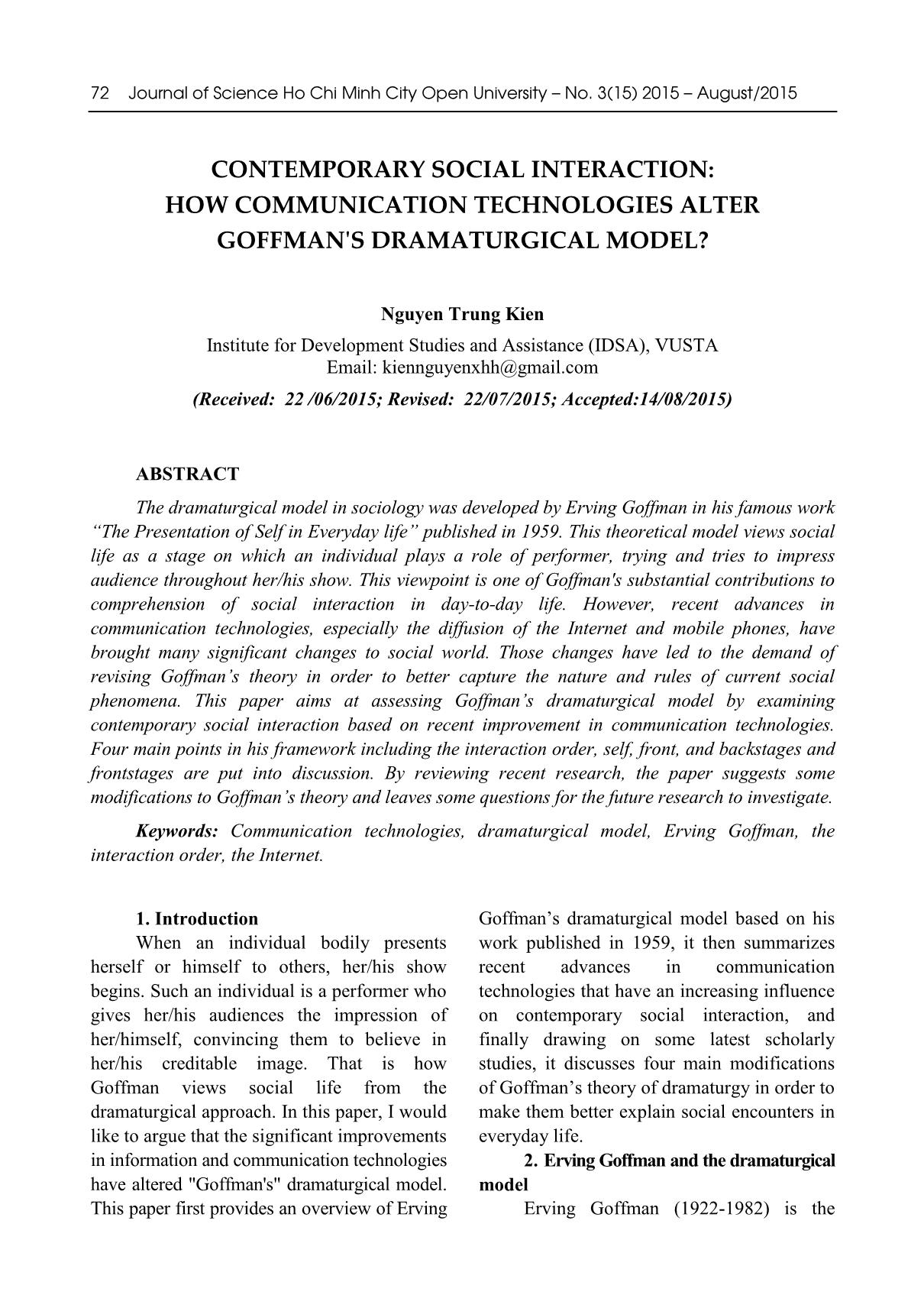
Trang 1
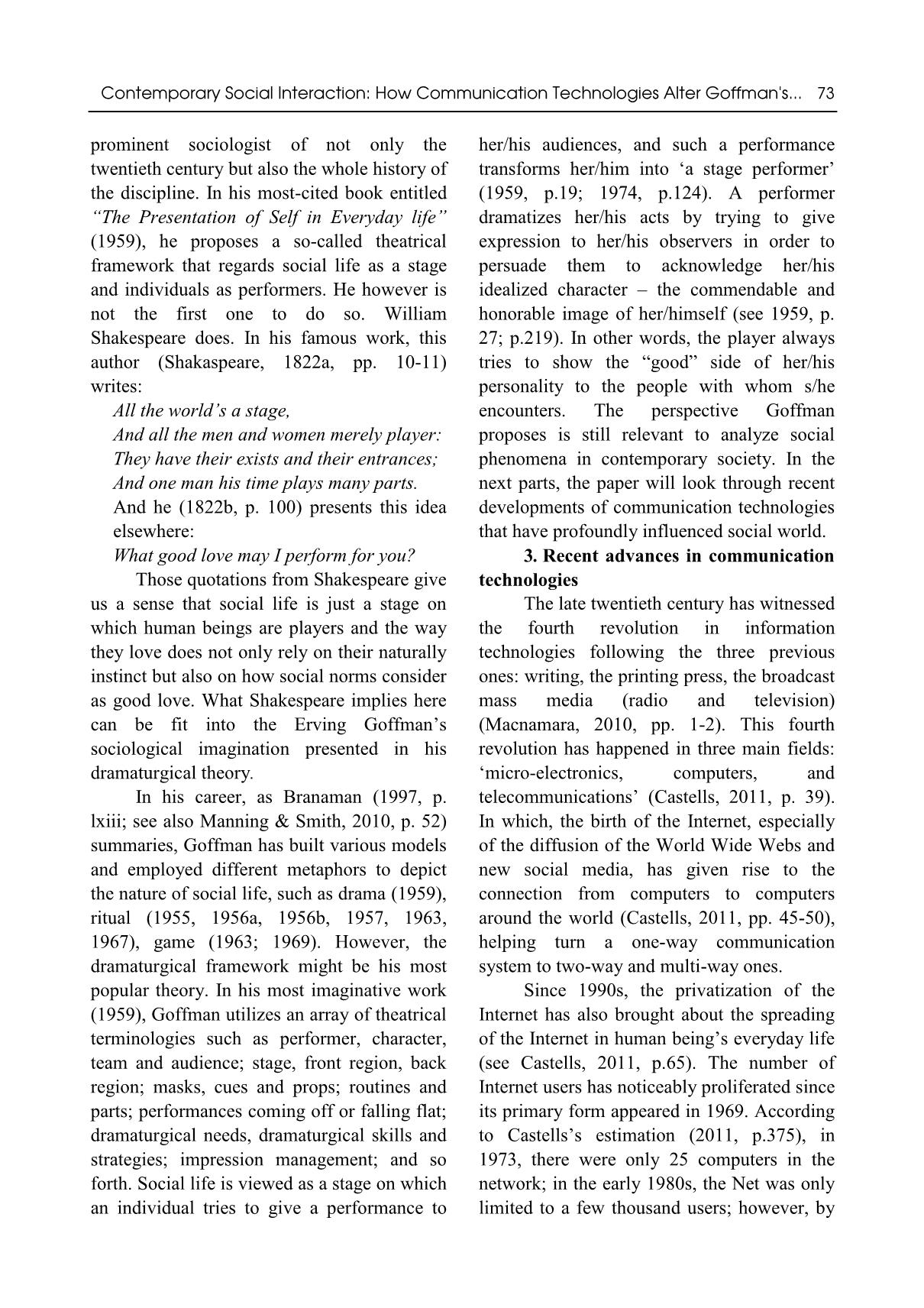
Trang 2
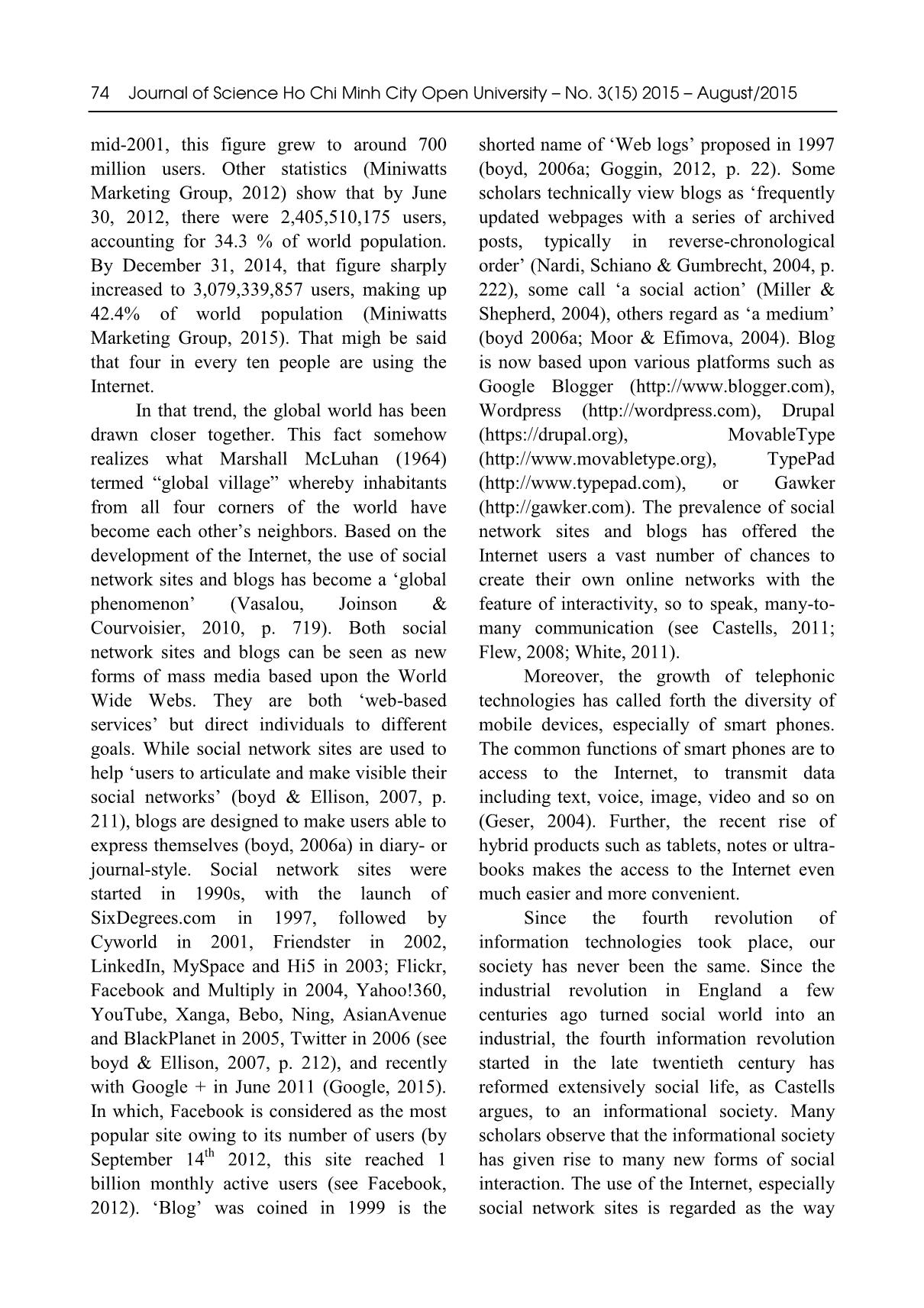
Trang 3
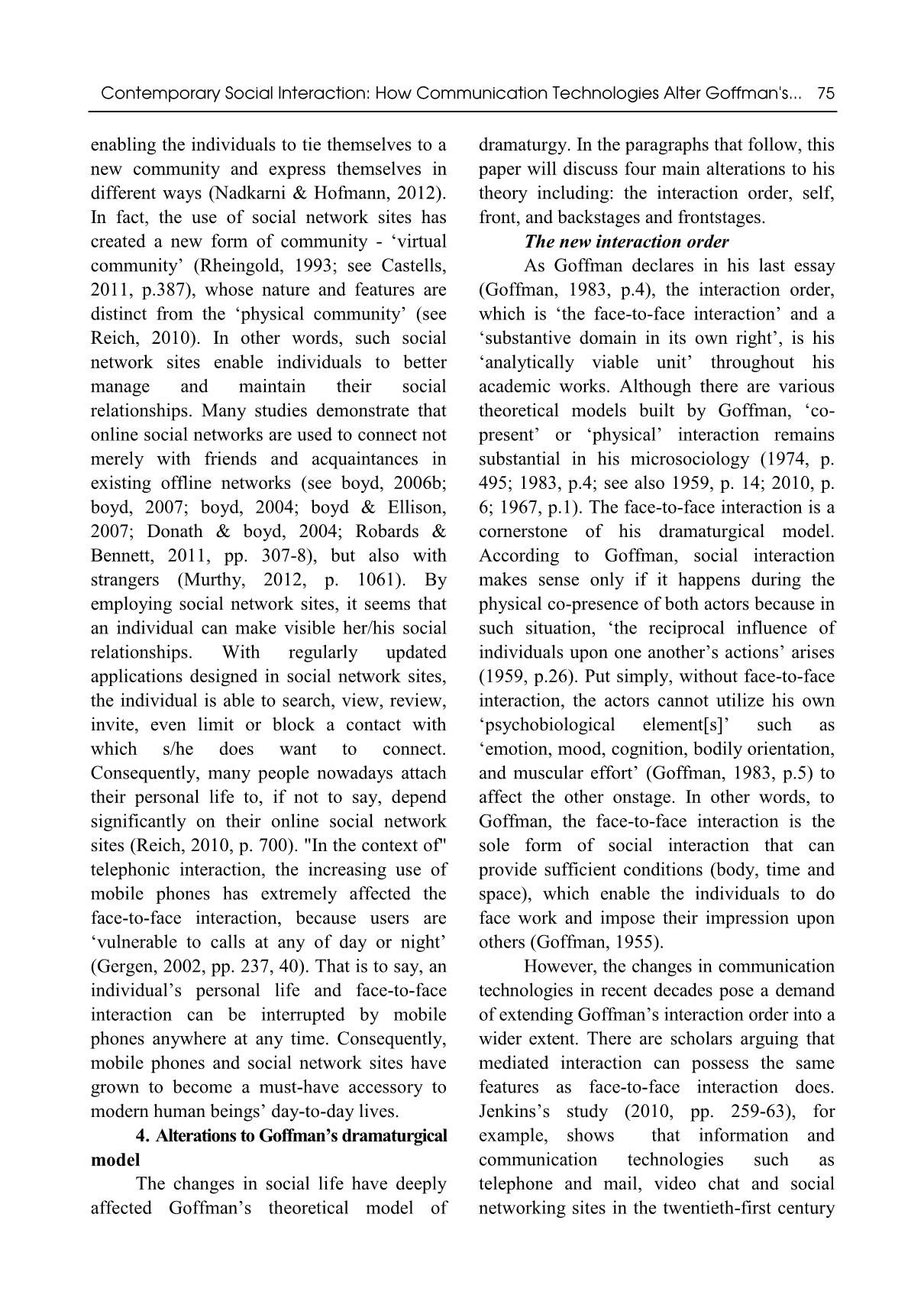
Trang 4
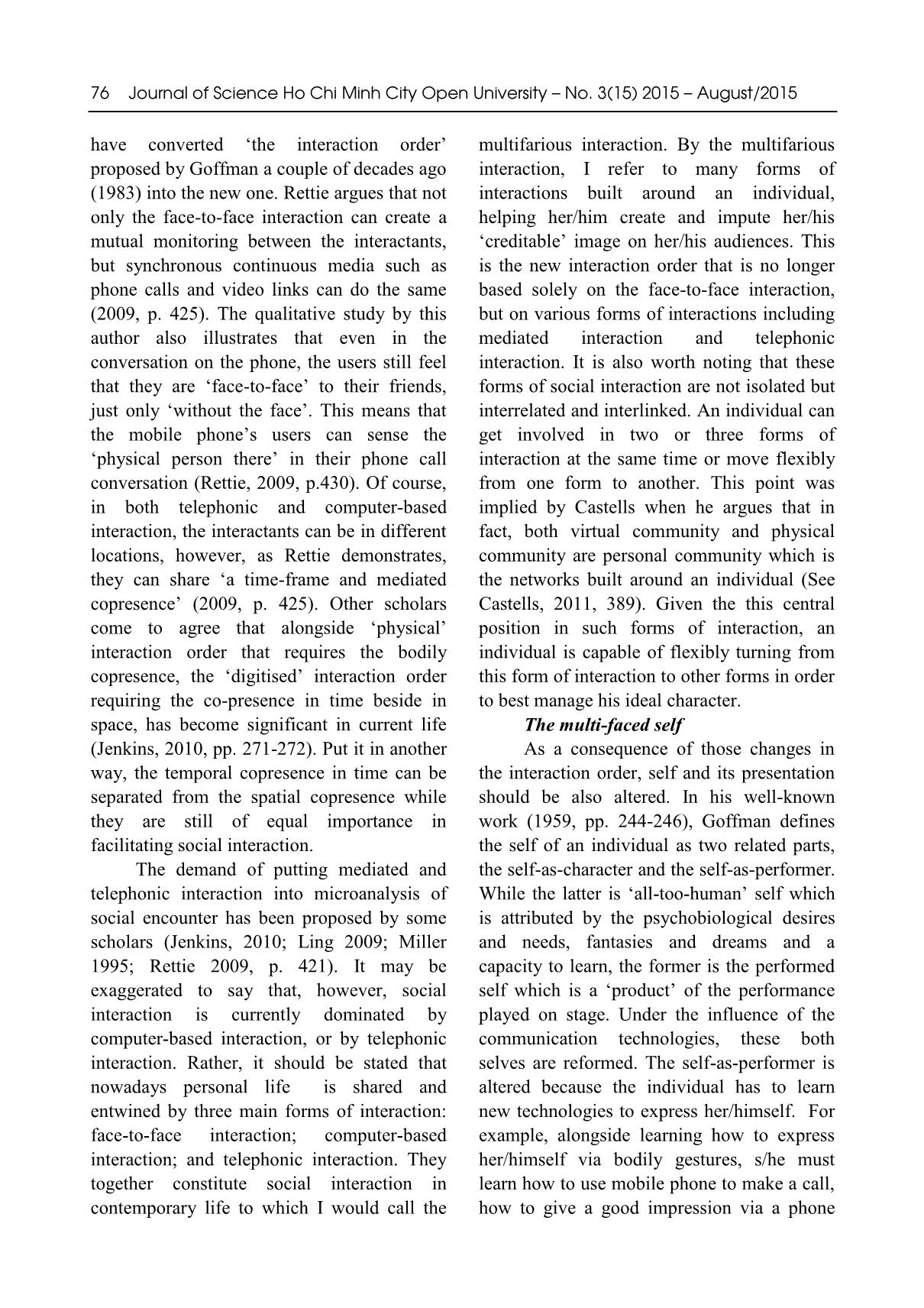
Trang 5

Trang 6
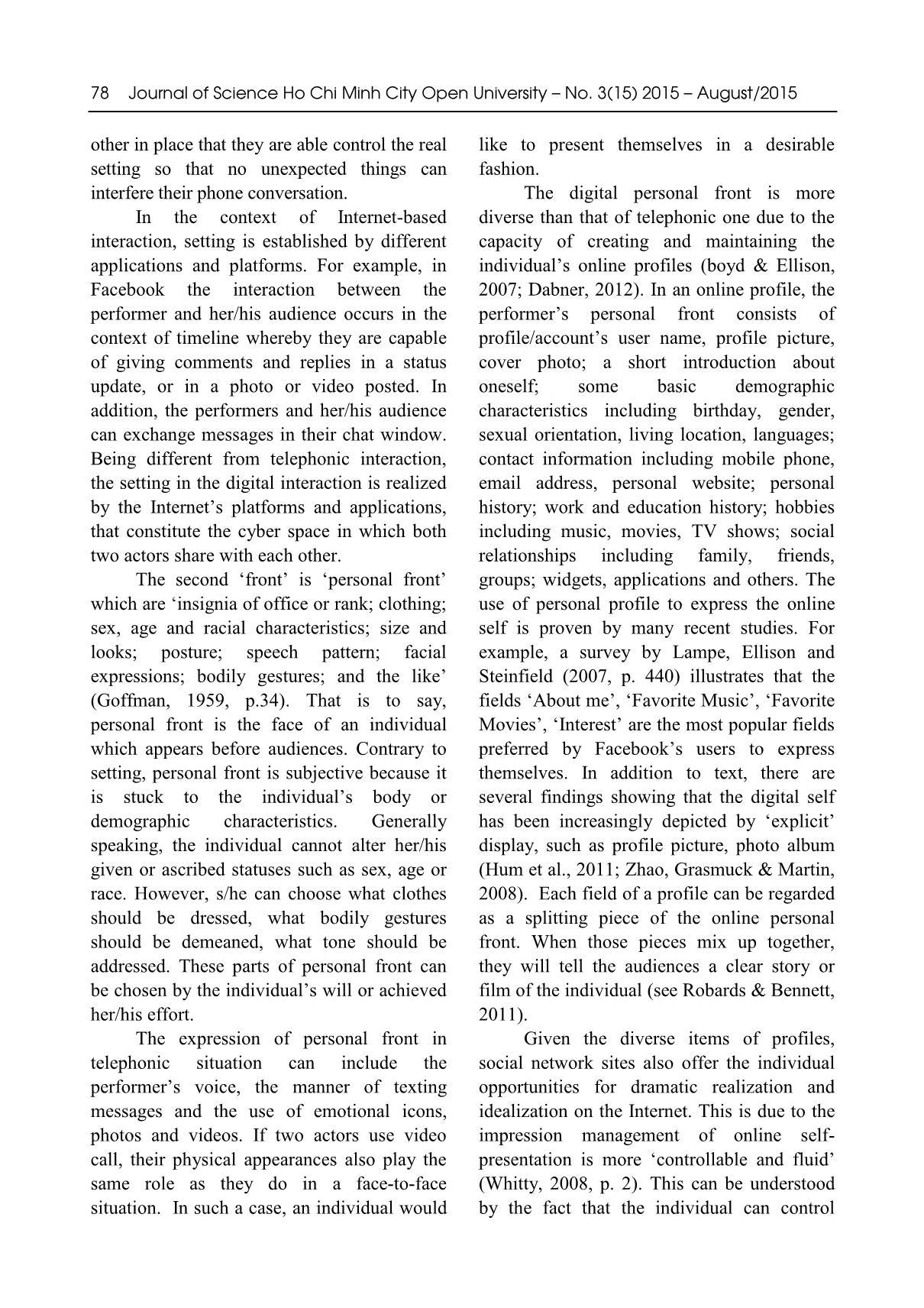
Trang 7

Trang 8

Trang 9
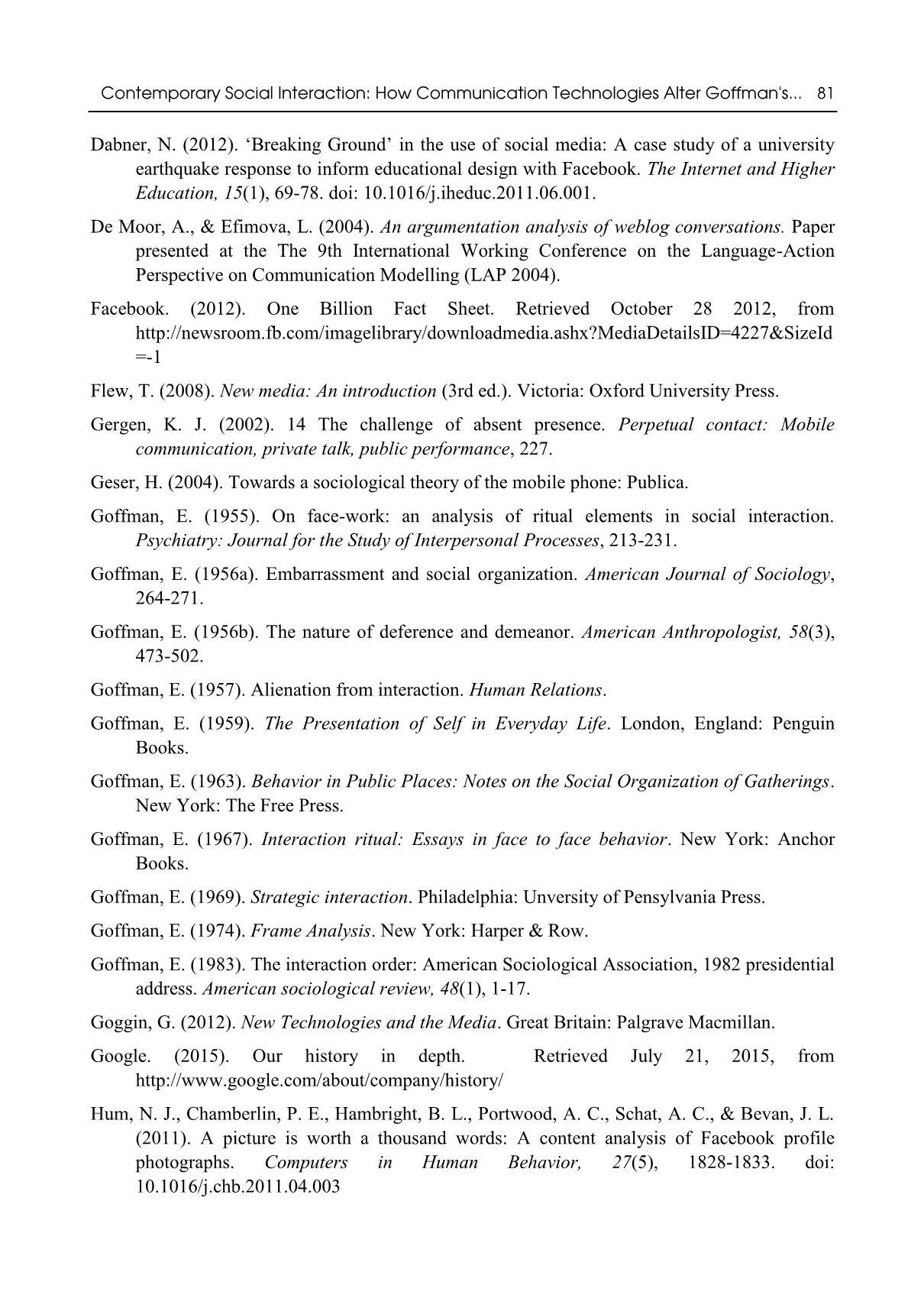
Trang 10
Tải về để xem bản đầy đủ
Tóm tắt nội dung tài liệu: Contemporary social interaction: How communication technologies alter goffman's dramaturgical model?
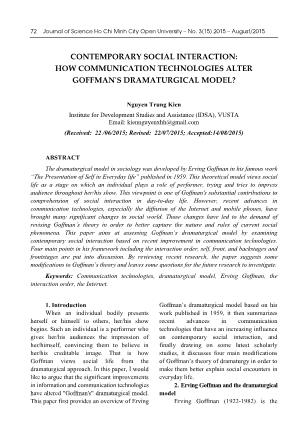
plicit’ display, such as profile picture, photo album (Hum et al., 2011; Zhao, Grasmuck & Martin, 2008). Each field of a profile can be regarded as a splitting piece of the online personal front. When those pieces mix up together, they will tell the audiences a clear story or film of the individual (see Robards & Bennett, 2011). Given the diverse items of profiles, social network sites also offer the individual opportunities for dramatic realization and idealization on the Internet. This is due to the impression management of online self- presentation is more ‘controllable and fluid’ (Whitty, 2008, p. 2). This can be understood by the fact that the individual can control Contemporary Social Interaction: How Communication Technologies Alter Goffman's... 79 which items should be published on the Internet in order to best portray her/his image. In other words, their audience might only view the ‘good’ or ‘admirable’ side of the performers (see Boon & Sinclair, 2009; Lampe, Ellison & Steinfield, 2007; Nosko, Wood & Molema, 2010) while other sides are hidden. This is similar to the case of mobile phone’s users where the individual is able to decide to give her/his phone number to expected people or to express her/his voice softer than usual to impress the hearers. The mix of backstage and frontstage The diversification of the social self and the interaction order requires us to reconsider the concepts of ‘frontstage’ and ‘backstage’. These terms are also called front region and back region in Goffman’s terminology. A frontstage is where an actor uses to organize her/his show, while a backstage is where the actor rehearses for her/his show but tries to keep it away from the audiences’ eyes. While the frontstage is where the individual gives the best out of her/him in order to make audiences see the desirable/admirable side of her/his personality, the backstage is where the individual presents her/his truer self, namely, s/he might behave in a manner s/he never wants to show in front of others. In the telephonic context, for example, the back region of the performance is the current setting in which s/he is staying, that is hidden from the fellow’s eyes. If two phone users use a video call, then the front region will be the limited part of the setting appearing in the phones’ cameras. In the case of normal calls, the front stage is not visible, because it appears only in the conversation between the individual and her/his audience. In the instance of the Internet, the back stage is the same as that of telephonic conversation, but the front stage is more electronically constructed. It is more visible than that of telephonic situation, because its situation is defined in terms of status updates or window chats or photos or videos uploaded or topics discussed. The most remarkable thing that attracts our attention is the entwinement between frontstages and backstages of three domains of interaction that the actor might involve. The actor no longer plays in a sole stage. Her/his participation in the physical setting, the telephonic setting and the digital setting can coincidence. Thus, it seems that we cannot sometimes draw a clear boundary between backstage(s) and frontstage(s). The use of mobile phone poses an essential case. For example, an individual is talking with her/his friends at a bar and then her/his mobile phone rings. In this case, the individual is currently the performer who plays before her/his friends as audiences and the space of the bar is the frontstage. However, when her/his mobile phone rings, s/he must talk with other friend via her/his mobile phone, so that s/he has to deal with two groups of audiences, one at the bar and one in the mobile phone conversation. The bar is the frontstage on which the individual gives the show to her/his friend, but it is also the backstage on which the individual uses to support her/his conversation with other friend via phone call. The mobile phone is the part of backstage in the phone call conversation but at the same time appears on the frontstage of the face-to-face talk. The fact that the mobile phone as a ‘backstage device’ can be brought onto frontstage of the face-to-face interaction, leads ‘what was the frontstage’ – the situation at the bar - to being ‘a type of backstage’ of the phone call situation (see Ling, 2009, p.278). The act of talking with other via mobile phone before a set of audiences, for instance, forces one deal with two frontstages at the same time, ‘the local one and the telephonic one’ (Ling, 2009, pp. 282, 288). This situation can be more complicated if the Internet-based interaction is involved. Imagine, for instance, an individual is talking 80 Journal of Science Ho Chi Minh City Open University – No. 3(15) 2015 – August/2015 with her/his friends at bar but s/he is also on Facebook or Skype by her/his laptop or tablet to chat with other friends or to post a status or a tweet. The situation is denser when her/his mobile phone rings. In this situation, the individual has to deal not with dual frontstages but treble frontstages: the local one, the telephonic one, and the virtual one. Her/his laptop and mobile phone are her/his backstage devices but also can be brought on face-to-face frontstage. The physical surroundings are on the frontstage of face-to- face interaction but can be used as backstage devices for the digital interaction or the telephonic interaction. Hence, in the interplay of three domains of interaction, the distinction between back regions and front regions is very fluid, and the impression management must be flexible. 5. Conclusion In this paper I have examined the influence of the recent improvements of communication technologies on the microsociology and the dramaturgical model proposed by Erving Goffman. This paper shows that the communication technologies, especially the Internet and social network sites have significantly contemporary social interaction. Through the dramaturgical lens, the interaction order has evolved to the extent that consists of not only the face-to-face interaction, but also the telephonic interaction and the digital interaction. In this new interaction order, the individual has to learn to express her/his self in new ways. S/he can choose to depict her/his self-image diversely from one domain to other. Her/his self can appear to be very different in one domain compared to that of in other domains. Her/his self is multi-faced self. The front in which the individuals play their shows is also diversified by each form of interaction. The individuals now have to take care of different frontstages and backstages if s/he wants to perform a good show for her/his own creditable image. These facts call forth a necessary alteration to Goffman’s dramaturgical model in order to better explain the contemporary phenomena. REFERENCES Bargh, J. A., McKenna, K. Y., & Fitzsimons, G. M. (2002). Can you see the real me? Activation and expression of the “true self” on the Internet. Journal of social issues, 58(1), 33-48. Boon, S., & Sinclair, C. (2009). A world I don’t inhabit: disquiet and identity in Second Life and Facebook. Educational Media International, 46(2), 99-110. Boyd, D. (2004). Friendster and publicly articulated social networking. Boyd, D. (2006a). A blogger\'s blog: Exploring the definition of a medium. Reconstruction, 6(4). Boyd, D. (2006b). Friends, Friendsters, and MySpace Top 8: Writing community into being on social network sites. First Monday, 11(12). Retrieved from: Boyd, D., & Ellison, N. B. (2007). Social network sites: Definition, history, and scholarship. Journal of Computer‐Mediated Communication, 13(1), 210-230. Branaman, A. (1997). Goffman's social theory. In C. Lemert & A. Branaman (Eds.), The Goffman Reader (pp. xlv-lxxxii). United Kindom: Wiley-Blackwell. Castells, M. (2011). The rise of the network society: The information age: Economy, society, and culture (Vol. 1): Wiley-Blackwell. Contemporary Social Interaction: How Communication Technologies Alter Goffman's... 81 Dabner, N. (2012). ‘Breaking Ground’ in the use of social media: A case study of a university earthquake response to inform educational design with Facebook. The Internet and Higher Education, 15(1), 69-78. doi: 10.1016/j.iheduc.2011.06.001. De Moor, A., & Efimova, L. (2004). An argumentation analysis of weblog conversations. Paper presented at the The 9th International Working Conference on the Language-Action Perspective on Communication Modelling (LAP 2004). Facebook. (2012). One Billion Fact Sheet. Retrieved October 28 2012, from =-1 Flew, T. (2008). New media: An introduction (3rd ed.). Victoria: Oxford University Press. Gergen, K. J. (2002). 14 The challenge of absent presence. Perpetual contact: Mobile communication, private talk, public performance, 227. Geser, H. (2004). Towards a sociological theory of the mobile phone: Publica. Goffman, E. (1955). On face-work: an analysis of ritual elements in social interaction. Psychiatry: Journal for the Study of Interpersonal Processes, 213-231. Goffman, E. (1956a). Embarrassment and social organization. American Journal of Sociology, 264-271. Goffman, E. (1956b). The nature of deference and demeanor. American Anthropologist, 58(3), 473-502. Goffman, E. (1957). Alienation from interaction. Human Relations. Goffman, E. (1959). The Presentation of Self in Everyday Life. London, England: Penguin Books. Goffman, E. (1963). Behavior in Public Places: Notes on the Social Organization of Gatherings. New York: The Free Press. Goffman, E. (1967). Interaction ritual: Essays in face to face behavior. New York: Anchor Books. Goffman, E. (1969). Strategic interaction. Philadelphia: Unversity of Pensylvania Press. Goffman, E. (1974). Frame Analysis. New York: Harper & Row. Goffman, E. (1983). The interaction order: American Sociological Association, 1982 presidential address. American sociological review, 48(1), 1-17. Goggin, G. (2012). New Technologies and the Media. Great Britain: Palgrave Macmillan. Google. (2015). Our history in depth. Retrieved July 21, 2015, from Hum, N. J., Chamberlin, P. E., Hambright, B. L., Portwood, A. C., Schat, A. C., & Bevan, J. L. (2011). A picture is worth a thousand words: A content analysis of Facebook profile photographs. Computers in Human Behavior, 27(5), 1828-1833. doi: 10.1016/j.chb.2011.04.003 82 Journal of Science Ho Chi Minh City Open University – No. 3(15) 2015 – August/2015 Jenkins, R. (2010). The 21st-century interaction order. In M. H. Jacobsen (Ed.), The contemporary Goffman (pp. 257-274). Lampe, C. A. C., Ellison, N., & Steinfield, C. (2007). A familiar face (book): profile elements as signals in an online social network. Paper presented at the Proceedings of the SIGCHI conference on Human factors in computing systems. Ling, R. (2009). The ‘Unboothed’Phone. Goffman and the Use of Mobile Communication. In M. H. Jacobsen (Ed.), The contemporary Goffman (pp. 275-292). New York: Routledge. Macnamara, J. (2010). The 21st century media (r) evolution: Emergent communication practices: Peter Lang Pub Incorporated. Manning, P., & Smith, G. (2010). Symbolic Interactionism. In A. Elliott (Ed.), The Routledge Companion to Social Theory (pp. 37-55). London & New York: Routledge. McLuhan, M. (1964). Understanding media: The extensions of man. London: Routledge and Kegan Paul. Miller, C. R., & Shepherd, D. (2004). Blogging as social action: A genre analysis of the weblog. In S. A. L. Gurak, L. Johnson, C. Ratliff, & J. Reyman (Ed.), Into the blogosphere: Rhetoric, community, and culture of weblogs. Retrieved from weblog.html. Miller, H. (1995). The presentation of self in electronic life: Goffman on the Internet. Paper presented at the Embodied knowledge and virtual space conference. Miniwatts Marketing Group. (2012). World Internet Usage and Population Statistics June 30, 2012. Retrieved June 1 2013, from Miniwatts Marketing Group Miniwatts Marketing Group. (2015). World Internet Usage and Population Statistics December 31, 2014. Retrieved July 21, 2015, from Miniwatts Marketing Group Murthy, D. (2012). Towards a Sociological Understanding of Social Media: Theorizing Twitter. Sociology, 46(6), 1059-1073. doi: 10.1177/0038038511422553 Nadkarni, A., & Hofmann, S. G. (2012). Why Do People Use Facebook? Pers Individ Dif, 52(3), 243-249. doi: 10.1016/j.paid.2011.11.007 Nardi, B. A., Schiano, D. J., & Gumbrecht, M. (2004). Blogging as social activity, or, would you let 900 million people read your diary? Paper presented at the Proceedings of the 2004 ACM conference on Computer supported cooperative work. Nosko, A., Wood, E., & Molema, S. (2010). All about me: Disclosure in online social networking profiles: The case of FACEBOOK. Computers in Human Behavior, 26(3), 406-418. Reich, S. M. (2010). Adolescents' sense of community on myspace and facebook: a mixed- methods approach. Journal of Community Psychology, 38(6), 688-705. doi: 10.1002/jcop.20389 Contemporary Social Interaction: How Communication Technologies Alter Goffman's... 83 Rettie, R. (2009). Mobile phone communication: Extending Goffman to mediated interaction. Sociology, 43(3), 421-438. Rheingold, H. (1993). The virtual community: Homesteading on the electronic frontier: MIT press. Robards, B., & Bennett, A. (2011). MyTribe: Post-subcultural Manifestations of Belonging on Social Network Sites. Sociology, 45(2), 303-317. doi: 10.1177/0038038510394025 Shakaspeare, W. (1822a). As You Like It. In W. Dodd (Ed.), The Beauties of Shakspeare: (pp. 6-13). London: Frederick Warne and Co. Shakaspeare, W. (1822b). King John. In W. Dodd (Ed.), The Beauties of Shakspeare: (pp. 93-104). London: Frederick Warne and Co. Vasalou, A., Joinson, A. N., & Courvoisier, D. (2010). Cultural differences, experience with social networks and the nature of “true commitment” in Facebook. International Journal of Human-Computer Studies, 68(10), 719-728. doi: 10.1016/j.ijhcs.2010.06.002 White, C. (2011). Social media, crisis communication, and emergency management. Leveraging Web 2.0 Technologies. Boca Raton: Taylor & Francis Group. Whitty, M. T. (2008). Revealing the ‘real’me, searching for the ‘actual’you: Presentations of self on an internet dating site. Computers in Human Behavior, 24(4), 1707-1723. Zhao, S., Grasmuck, S., & Martin, J. (2008). Identity construction on Facebook: Digital empowerment in anchored relationships. Computers in Human Behavior, 24(5), 1816- 1836. doi: 10.1016/j.chb.2008.02.012.
File đính kèm:
 contemporary_social_interaction_how_communication_technologi.pdf
contemporary_social_interaction_how_communication_technologi.pdf

